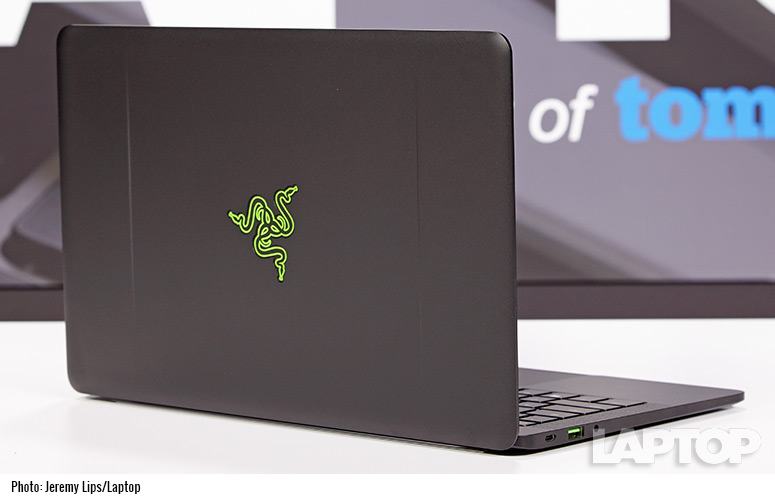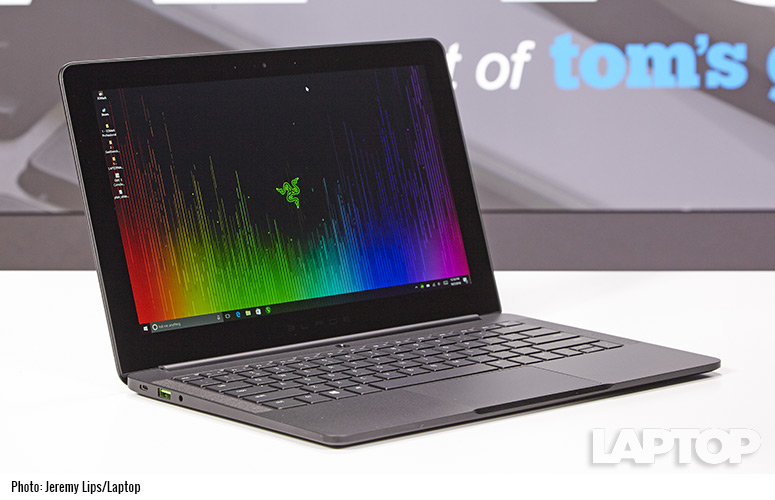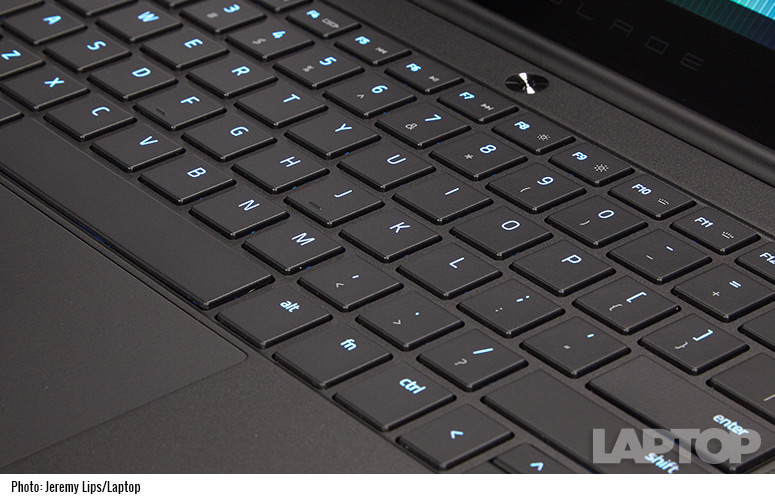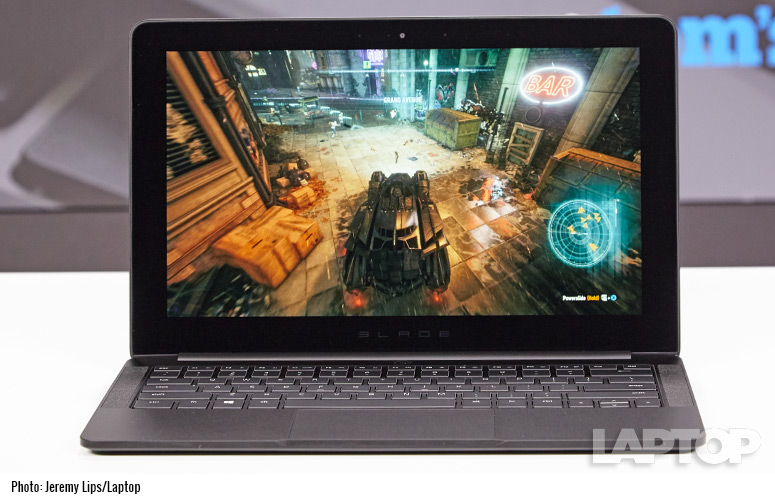Laptop Mag Verdict
With Intel Kaby Lake inside, the Razer Blade Stealth remains one of the prettiest, most powerful ultraportables on the market, but it could still use more battery life.
Pros
- +
Stunning, lightweight design
- +
Great performance
- +
Bright, vivid quad-HD display
- +
Beautiful, customizable keyboard
Cons
- -
Keyboard is a bit stiff
- -
Below-average battery life
Why you can trust Laptop Mag
From its striking beauty to its potent performance, the latest Razer Blade Stealth has something for everyone. Starting at $899, the 12.5-inch Ultrabook packs an attractive, quad-HD display; a customizable keyboard; and speedy components into a sleek, 2.8-pound chassis. We had the opportunity to test both the Core i5 base model and a $1,249 Core i7 configuration with more storage and a touch screen. In both cases, we experienced snappy multitasking and sharp image output, though the systems suffered from below-average battery life.
Design
Whereas other laptops are using elaborate color schemes to stand out, Razer sticks with a tried-and-true, all-black, attractive CNC aluminum chassis. The familiar accent lines on the lid draw the eye to the glowing green tri-snake emblem. The notebook's interior has more of that sexy ebony aluminum, which helps to highlight the gorgeous glowing keyboard and equally lovely 12.5-inch display.
The Stealth's diminutive frame makes it hard to load it up with ports, but the ones it does have can turn the ultraportable into the brain of a formidable gaming or productivity station. Along the right, you'll find a full-size HDMI port and a USB 3.0 port. On the opposite side, Razer adds another USB 3.0 port with a headset jack, as well as a Thunderbolt 3.0 port that doubles as the AC charging port.
Measuring 12.6 x 8.1 x 0.52 inches and weighing 2.8 pounds, the Stealth is about the same size and weight as the Dell XPS 13 (11.9 x 7.9 x 0.3~0.6 inches, 2.7 pounds). However, other ultraportables are considerably lighter. The HP Spectre (12.8 x 9 x 0.41 inches) weighs 2.5 pounds, while the Apple MacBook (11 x 7.7 x 0.14~0.52 inches) and Asus ZenBook 3 (11.7 x 7.3 x 0.47 inches) barely tip the scale at 2.03 and 2 pounds, respectively.
MORE: Best Ultrabooks (Thin-and-Light Windows Laptops)
Display
Sign up to receive The Snapshot, a free special dispatch from Laptop Mag, in your inbox.
The Stealth's 12.5-inch, 2560 x 1440 touch display remains a thing of utter beauty. The pinks were so vivid during the Tears of Steel 4K trailer, they were almost fluorescent and the green ivy was radiant against the gray, desiccated rubble. Details were sharp enough that I could see the fibers in the thick, braided shoulder accents that gave way to large, red snakeskin scales.
All that vividness can be attributed to the panel's ability to reproduce 115 percent of the sRGB gamut, which is much better than the 96-percent ultraportable average. The ZenBook 3 and the MacBook came closest to matching the Stealth, at 111 percent and 107 percent, respectively. The Spectre hit 100 percent, while the XPS 13 missed the mark, at 94 percent.
Registering 0.97 on the Delta-E test (0 is ideal), the Stealth also has one of the most accurate displays on the market. It easily bested the 2.1 average as well as the results put up by the MacBook (1), ZenBook 3 (1.1) and HP Spectre (1.2). The XPS 13 came out on top, with a score of 0.76.
For such a shadowy moniker, the Stealth's panel is plenty bright, outputting 335 nits and besting the 301-nit category average. The MacBook (327 nits), ZenBook 3 (309 nits) and XPS 13 (302 nits) couldn't hold a candle to Razer's laptop, but the Spectre and its 359-nit panel managed to outshine everything.
Audio
The audio you get from the Stealth's diminutive speakers is louder than you'd expect from a notebook this size. However, during several tracks -- including Miguel's "Vixen" and Jill Scott's "Fools Gold" -- the bass, while present, was rather diffused. The speakers did a solid job of delivering Solange's airy vocals on "Cranes In The Sky."
Razer preinstalled Dolby's Digital Plus audio software, which features four profiles (Movie, Music, Game and Voice), and it definitely helped to amplify the laptop's audio. The Music profile gave the best result -- a nice balance of warmth and clarity. You can also create your own custom profiles using the Intelligent Equalizer and Surround Virtualizer.
Keyboard and Touchpad
Whoa, the colors man. Look at all the colors. Razer wisely opted to keep the visual cornucopia that is the Chroma keyboard. Because the keyboard can recreate up to 16.8 million colors with several captivating effects, I found myself staring at the keys, mesmerized by the light show.
When I'd gotten my fill of gawking, I started typing and was quickly disappointed by the shallow 0.87-millimeter travel. When that slow travel was paired with the 58 grams of actuation needed to press the keys, my fingertips quickly bottomed out, making for an uncomfortable experience. Nevertheless, I managed to hit my 65 word-per-minute average on the 10fastfingers.com typing test.
Razer kept its 4.1 x 2.5-inch Synaptics touchpad. Thanks to the rather small palm rest, it looks bigger than it actually is, but it still offered agile, accurate responses when I pinch-zoomed an article or did a four-finger flick to switch between open apps. The bottom corners of the pad delivered clicky, punchy feedback when pressed.
Synapse
It just wouldn't be a Razer laptop without Synapse, the company's cloud-based software that allows you to tweak the macros, set trackpad sensitivity, track your keystrokes and configure your keyboard's color palette. You also have access to the Chroma Apps store, which allows games such as Dota 2, Rise of the Tomb Raider and Overwatch to integrate their unique lighting effects into the game. Best of all, your carefully created masterpieces are saved in the cloud and can be used with other Razer devices.
MORE: The Best Laptops for Every Need
Performance
The era of Kaby Lake is upon us, and I couldn't be more elated. Intel claims its 7th-generation processors deliver better performance while extending battery life. Equipped with a 7th-gen 2.7-GHz Intel Core i7-7500U CPU with 16GB of RAM, the Stealth ably streamed an episode of Luke Cage while running a full system scan with 13 tabs open in Google Chrome.
We also got our hands on a model with a 2.5-GHz Intel Core i5-7200U CPU with 8GB of RAM. Though not as powerful as a Core i7, this config is quite fast. I had no problem running a Windows Defender scan while streaming Ava DuVernay's "13th" from Netflix with 10 Google Chrome tabs open.
The Core i7 Stealth notched 7,871 on our synthetic Geekbench 3 test, easily beating the 5,528 average for ultraportable notebooks. Outfitted with their own Core i7-7500U CPUs, the HP Spectre and the Asus ZenBook 3 hit 7,888 and 7,647, respectively. The Dell XPS 13 (Intel Core i5-7200U CPU) delivered 7,159, while the MacBook and its 1.2-GHz Core m5 processor obtained a rather disappointing 5,906. The Core i5 Stealth delivered a hearty 7,075.
During the File Transfer test, the Core i7 Stealth's 256GB M.2 PCIe solid-state drive duplicated 4.97GB of mixed media files in 14 seconds, which translates to a transfer rate of 363.5 megabytes per second. That scorches the 164.5-MBps average as well as the 355.9 MBps, 339.3 MBps and 195.9 MBps put up by the MacBook (512GB SSD), XPS 13 (256GB SSD) and Spectre (256GB SSD), respectively. However, the ZenBook pulled out the win with its 512GB PCIe SSD (508.9 MBps). The Core i5 version of the Stealth and its 128GB M.2 PCIe SSD missed the mark, with 118.3 MBps.
On the OpenOffice Spreadsheet Macro test, the Core i7 Stealth paired 20,000 names and addresses in 3 minutes and 39 seconds, sailing past the 6:25 average as well as the Core i5 Stealth (4:06), Spectre (3:59) and XPS 13 (3:55). However, it couldn't keep pace with the ZenBook (3:34) or the MacBook (3:11).
Graphics Performance
Although Kaby Lake ushers in the new Intel HD Graphics 620 GPU, don't expect to start playing Gears of War 4 or The Witcher 3 on the Stealth or any other ultraportable. However, you can get away with playing less demanding titles, like Dirt 3. On 1080p at high settings, the Stealth turned in 28 frames per second, matching the XPS 13 and beating the 24-fps average. The ZenBook 3 turned in a significantly higher 47 fps.
When we ran the 3DMark Ice Storm Unlimited benchmark, the Stealth notched 69,207, which was enough to top the 52,219 ultraportable average as well XPS 13's (Intel HD Graphics 5500 GPU) 62,754. However, the Spectre and its last-gen Intel HD Graphics 520 GPU achieved 69,409. But the ZenBook 3 and its Intel HD Graphics 620 GPU were the ultimate winner, scoring 70,628.
If you're planning to do any gaming, you'll have to invest in the Razer Core, the company's $399 graphics amplifier. When paired with a desktop graphics card of your choosing, the Core will bypass the Stealth's integrated graphics, allowing you to play even the most taxing games.
Battery Life
The Core i7 Stealth lasted 6 hours and 36 minutes on our battery test (continuous web surfing over Wi-Fi), while the Core i5 version posted 6:58. Both results are a marked improvement over the previous generation's 5:05. They also outlasted the Spectre's time of 6:06. However, it was nowhere near the 8:08 ultraportable-notebook average and also below the ZenBook 3's 7:05. The MacBook lasted an impressive 9:38, while the XPS 13 actually lapped the Stealth with a time of 13:49.
MORE: Laptops with the Longest Battery Life
Heat
With such a slim profile, it can be hard for a laptop to stay cool as there's little room for heat to escape. But the Stealth, with its all-aluminum chassis, does a decent job of it. After we streamed 15 minutes of a full-screen YouTube video, the touchpad and the center of the notebook measured 88 and 91 degrees Fahrenheit, respectively. The Stealth's undercarriage hit 97 degrees, which is slightly warmer than our 95-degree comfort threshold.
Webcam
The Stealth's integrated webcam captures images and video in 1920 x 1080 and does a pretty good job. The test shots I took in the lab captured the varying shades of purple, orange and black in my locks, as well as the black and white stripes in my dress.
Software and Warranty
As usual, Razer employs a light touch on the software. Aside from your typical Windows 10 software, you get Razer Comms, the company's voice-chat gaming messenger, which lets you chat for free on mobile and desktop. The messenger also features a handy in-game overlay, so you can talk without leaving your game.
Third-party apps include Flipboard; Twitter; Killer Diagnostic, which keeps tabs on network speeds; and Killer Network Manager, which allows you to maximize online gaming performance by configuring the network card.
Configurations
I had a grand old time reviewing the $1,249 iteration of the Razer Blade Stealth, which includes a 2.7-GHz Intel Core i7-7500U CPU with 16GB of RAM, a 256GB M.2 PCIe SSD, an Intel HD Graphics 620 GPU and a 2560 x 1440 touch display. The $999 base model halves the RAM and storage to 8GB and 128GB, respectively, while the $899 version, which we also tested, swaps out the Core i7 processor for a 2.5-GHz Intel Core i5-7200U CPU.
If you're looking for a better display and more storage, consider the $1,599 version, which outfits the Stealth with a 3840 x 2160 touch panel and a 512GB PCIe SSD.
Bottom Line
The $1,249 Razer Blade Stealth hovers on the brink of greatness. It's a simply gorgeous piece of machinery, accented by a lovely quad-HD display and a tantalizing Chroma keyboard. Then there's the Kaby Lake processor and integrated graphics, which deliver a one-two punch of overall performance and graphics prowess with a relatively speedy PCIe SSD.
And if you want to keep the price tag below $1,000, the $899 Core i5 configuration is an olive branch to consumers previously put off by Razer's prohibitive pricing. The optional $399 Core graphics amp can complete the package, by transforming the Stealth from a sexy productivity machine into an unadulterated gaming beast.
For Razer to win, though, it will need to work on extending the Blade Stealth's battery life even further and adding some cushion to the otherwise stunning keyboard. The $1,074 Asus ZenBook 3 is thinner and lighter, and offers comparable performance, but you'll have to pay $1,599 for the cool blue color. The $1,299 Apple MacBook and the Dell XPS 13 are better choices if you need longer battery life.
Overall, the Razer Blade Stealth is a very good choice for mobile professionals or students by day and, if you spring for the amp, hard-core gamers by night.
- Best 2-in-1s (Laptop/Tablet Hybrids)
- Best Dell and Alienware Laptops
- Our Favorite Tablets for Work and Play
Razer Blade Stealth (February 2017) Specs
| Brand | Razer |
| CPU | Intel Core i7-7500U |
| Company Website | www.razerzone.com |
| Display Size | 12.5 |
| Hard Drive Size | 256GB |
| Hard Drive Type | SSD |
| Native Resolution | 2560 x 1440 |
| Operating System | Windows 10 Home |
| RAM | 16GB |
| RAM Upgradable to | 16GB |
| Touchpad Size | 4.1 x 2.5 inches |
| Weight | 2.8 |

Sherri L. Smith has been cranking out product reviews for Laptopmag.com since 2011. In that time, she's reviewed more than her share of laptops, tablets, smartphones and everything in between. The resident gamer and audio junkie, Sherri was previously a managing editor for Black Web 2.0 and contributed to BET.Com and Popgadget.




